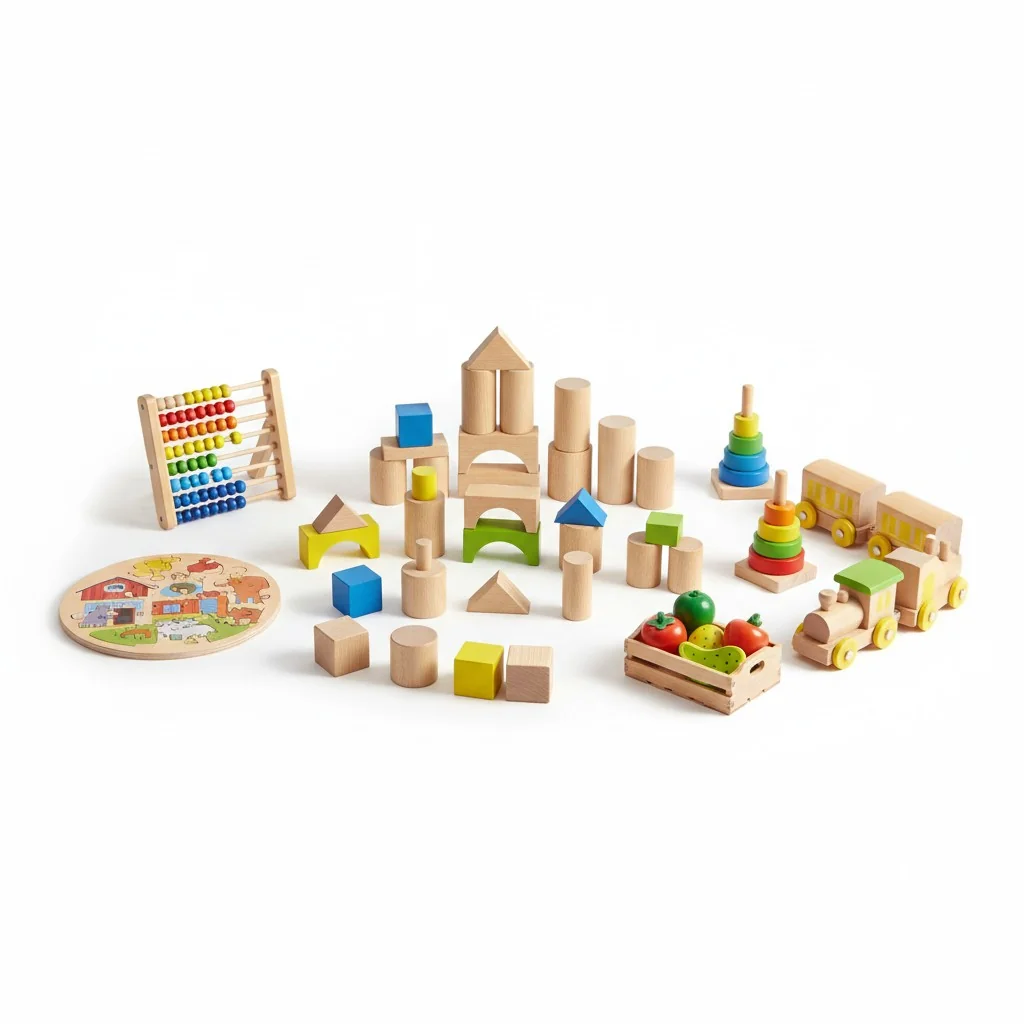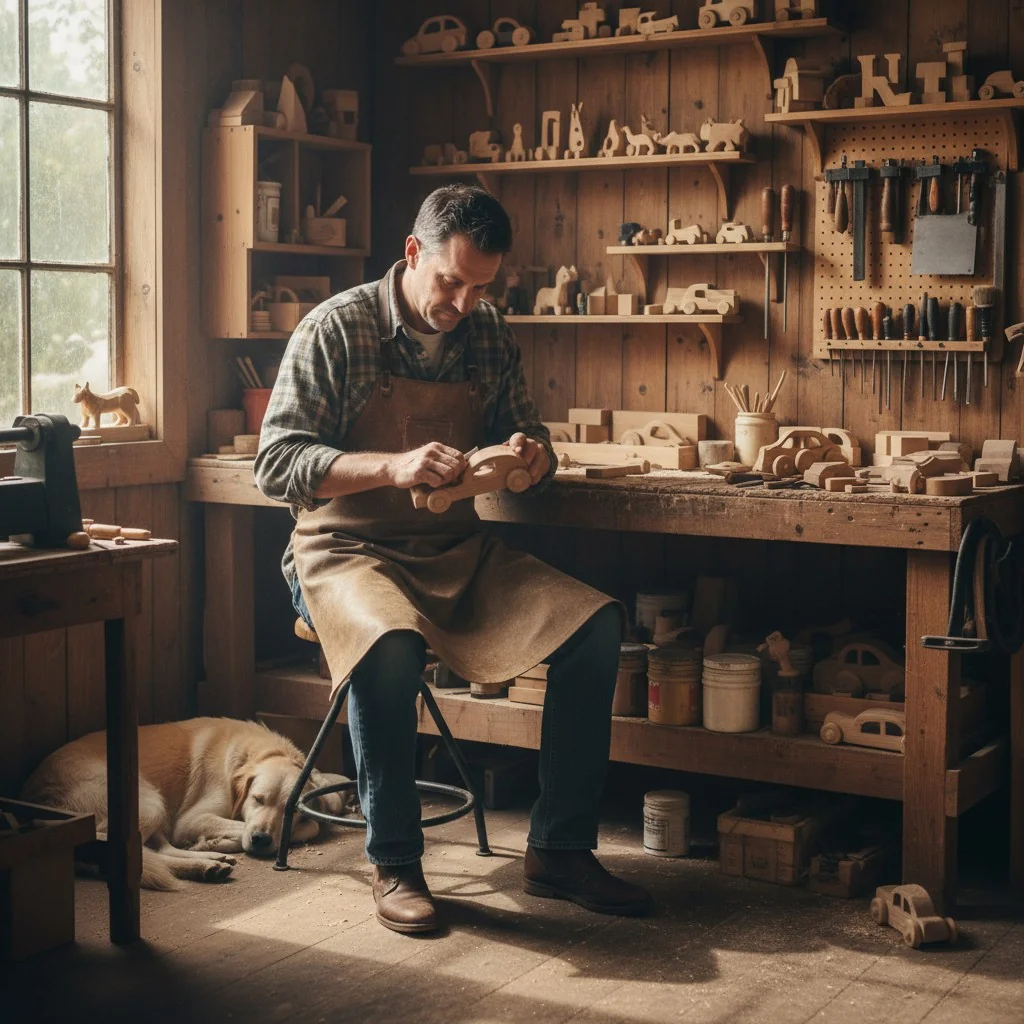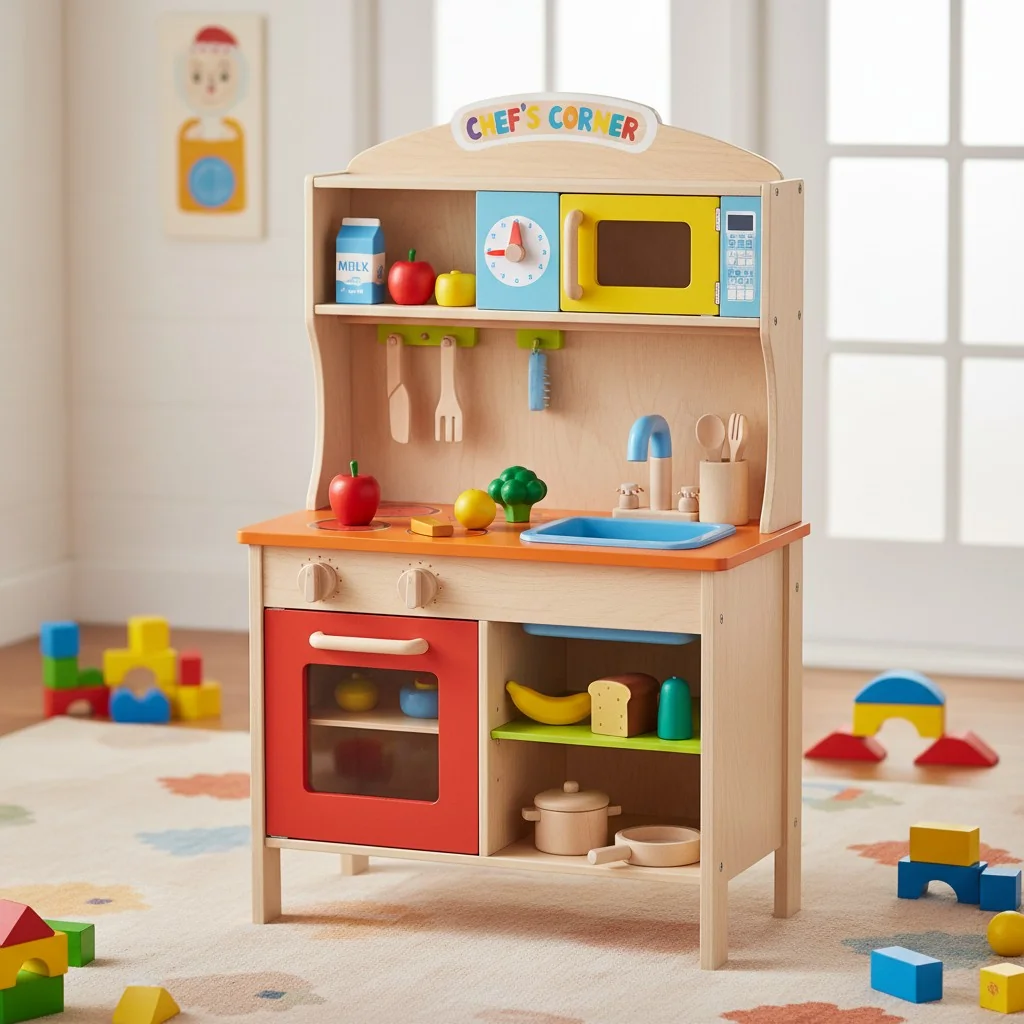
Want to enter the profitable wooden toy market but don't know where to start? Choosing the wrong product can be a very costly mistake. Let's analyze the market together.
The best-selling wooden toys are often classic, open-ended items like building blocks, puzzles, and vehicles. These toys have timeless appeal, encourage creativity, and are valued by parents for their educational benefits and durability. Market trends show a strong preference for sustainably sourced[^1], non-toxic options.

This might sound simple, but there is much more to it. Before you even think about mold design or production lines, you need to understand the market's details. I have helped many clients make these big decisions. In my experience, success always starts with good, solid research. It's the foundation for everything that follows. Let's break down what you need to know to make the right choice for your business.
The global wooden toys market was valued at approximately USD 2.5 billion in 2022.True
Multiple market research reports confirm this valuation, with slight variations. It shows a significant and established market.
All wooden toys are environmentally friendly.मिथ्या
This is a common misconception. The sustainability of a wooden toy depends on the source of the wood (e.g., FSC-certified forests), the manufacturing process, and the types of finishes (paints, glues) used.
How is the market for wooden toy makers?
The toy market seems crowded and very competitive. It is easy to feel lost and think you cannot compete. But there is a growing, profitable niche waiting for you.
The market for wooden toy makers is strong and growing. Consumers are increasingly seeking sustainable, durable, and educational alternatives to plastic toys. This trend creates significant opportunities for businesses that focus on quality craftsmanship, safety, and eco-friendly materials. The global wooden toys market[^2] is projected to grow steadily.

When I started my own company, I learned that understanding market trends[^3] is just as important as understanding your machinery. The wooden toy market is a perfect example. It's not just about nostalgia. There are real business drivers pushing its growth. Parents today are more informed than ever. They want toys that last and help their children learn. They are also very concerned about the environment and the safety of the materials their kids touch. This is a huge shift away from the cheap, disposable plastic toys that dominated for years. For a business, this means you can compete on quality, not just price. You can build a brand that parents trust.
Key Market Drivers
- Sustainability: Parents want products from renewable resources.
- Educational Value: A focus on STEM and developmental skills is high.
- Safety: Concerns over chemicals in plastics (like BPA) drive parents to natural materials.
| Sales Channel | Pros | Cons | को लागी सबै भन्दा राम्रो |
|---|---|---|---|
| Direct to Consumer (B2C) | Higher profit margins, direct customer feedback. | Requires marketing, customer service, and logistics. | Small artisans, niche brands. |
| Business to Business (B2B) | Large volume orders, stable income. | Lower profit margins, requires meeting strict standards. | Businesses aiming to scale by supplying schools, retailers. |
The wooden toys market is expected to grow at a compound annual growth rate (CAGR) of over 7% from 2023 to 2030.True
Market analysis reports from firms like Grand View Research and Allied Market Research project this strong growth, driven by rising disposable income and awareness of the benefits of wooden toys.
Wooden toys are always more expensive to produce than plastic toys.मिथ्या
While high-quality hardwoods can be expensive, simple wooden toys can be cheaper to produce at a small scale than plastic toys, which require expensive molds and machinery for injection molding.
What type of wooden toy sells the best?
You know the market is good, but what specific product should you make? Guessing can lead to a warehouse full of unsold inventory. Let's look at the data on top-sellers.
The best-selling wooden toys consistently fall into categories that promote open-ended play[^4]. These include building blocks, train sets, puzzles, and play kitchens. Their success comes from their ability to grow with a child and offer high play value, making them a worthwhile investment for parents.

In my business, I always advise clients to look for "evergreen" products. These are items that are always in demand, year after year. In the toy world, these are the classics. Think about it from a designer's perspective, like Jacky's. The design challenge isn't to invent something completely new, but to perfect a classic. How can you make a better set of building blocks? Can you design a puzzle with a unique theme or a clever mechanism? The manufacturing process for these items is also well-understood, which reduces risk. While evergreen products are a safe bet, there are also exciting niche opportunities. Montessori-inspired toys[^5], for example, are hugely popular. These focus on simple, realistic items that help children learn practical life skills.
| Toy Category | Target Age | Key Skills Developed | जटिलता जटिलता |
|---|---|---|---|
| building blocks[^6] | 1-8 years | Spatial reasoning, creativity, fine motor skills | Low to Medium |
| पजोट | 2-10 years | Problem-solving, shape recognition, patience | Medium |
| Train Sets | 3-7 years | Imaginative play, planning, fine motor skills | Medium to High |
| Play Kitchens | 3-6 years | Social skills, imaginative play, vocabulary | High |
Montessori-style toys focus on abstract concepts and bright, primary colors.मिथ्या
Montessori toys are typically based on realism. They use natural materials and realistic colors to help children understand the world as it is. The focus is on practical skills, not abstract ideas.
The concept of 'open-ended play' means toys can be used in many different ways, not just one.True
This is the core definition. A stick is an open-ended toy (it can be a wand, a sword, a bridge), while a character-specific electronic toy with set phrases is a 'closed-ended' toy.
What type of wood is used for toys?
Choosing the right material is critical for safety and durability. The wrong wood can splinter, contain toxins, or be too expensive for your product. Here is how to select the best wood.
The best woods for toys are durable, non-toxic hardwoods that do not splinter easily. Maple, birch, and beech are top choices due to their smooth grain and strength. Softer woods like pine can be used but require careful finishing to ensure safety. Always prioritize untreated, sustainably sourced wood.

This is where my experience in manufacturing becomes really important. The material you choose affects everything: the design, the production process, the cost, and the final product's safety. For a designer like Jacky, this is a critical decision. You can't just pick a wood because it looks nice. You have to think about how it will be machined, how it will wear over time, and if it meets international safety standards[^7]. For example, hardwoods like maple are fantastic. They are dense, so they resist dents and don't splinter. But they are also more expensive and harder on your tools. Pine is cheaper and easier to work with, but it's soft and can dent easily. You must also consider the finish. You must use non-toxic paints and sealants that are certified safe for children. This is not a place to cut corners.
| Wood Type | Hardness | Cost | Grain/Texture | Best Use Case |
|---|---|---|---|---|
| Maple | High | High | Fine, smooth | Blocks, cars, high-contact parts |
| Beech | High | Medium-High | Fine, straight | Blocks, figures, train tracks |
| Birch | Medium | Medium | Smooth, even | Puzzles, general-purpose toys |
| Pine | Low | Low | Coarse, knots | Larger items (play kitchens), requires careful finishing |
| Rubberwood | Medium | Low-Medium | Dense, coarse | Eco-friendly option for blocks and furniture |
The European toy safety standard is known as EN 71.True
EN 71 is the primary set of safety standards for toys sold in the European Union. It covers mechanical properties, flammability, and chemical migration, among other things.
All hardwoods are safe for toys.मिथ्या
While many hardwoods are great, some, like oak, have a very open grain that can trap dirt and are more prone to splintering than maple or beech, making them less ideal for toys that will be handled by small children.
What type of toys are building blocks?
Building blocks seem simple, but what makes them so special? Underestimating their value means you are missing a huge market opportunity. They are a powerhouse of child development.
Building blocks are a classic example of an "open-ended" or "loose parts" toy. They do not have a single, prescribed way to be used, which encourages creativity, problem-solving, and spatial reasoning. This makes them a foundational toy for early childhood development across various age groups.

From a manufacturing and design standpoint, blocks are a fascinating product. They look simple, but precision is everything. I've seen clients fail because their blocks didn't stack properly. If the dimensions are off by even a small amount, the child's tower will fall, and the toy becomes frustrating instead of fun. This is where good design and quality control are key. A classic "unit block" system is based on a standard measurement. The base block is a certain size, and all other blocks are multiples or fractions of that size (e.g., two squares equal one rectangle). This mathematical relationship is what makes them so powerful for learning. As a designer, you can innovate by introducing new shapes, colors, or even materials, but you must respect the core principle of precision for the toy to be successful.
| Block Type | Primary Focus | Key Design Feature |
|---|---|---|
| Unit Blocks | Math, spatial reasoning | Standardized, proportional sizes |
| Alphabet Blocks | Literacy, letter recognition | Letters and images on faces |
| Architectural Blocks | Creativity, design | Unique shapes inspired by buildings |
| "Loose Parts" Blocks | Creativity, nature | Irregular, natural shapes (e.g., wood offcuts) |
Friedrich Froebel, the inventor of Kindergarten, developed a series of educational toys called 'Gifts', which included wooden blocks.True
Froebel's Gifts were a systematic curriculum of objects, starting with a simple ball and progressing to more complex sets of blocks, to teach children about shapes, relationships, and creativity.
The main purpose of building blocks is to teach children the alphabet.मिथ्या
While alphabet blocks exist, the primary purpose of most building block sets is to develop spatial skills, motor skills, creativity, and problem-solving. Literacy is a secondary benefit for specific types of blocks.
What are some of the best wooden toys for kids?
You need concrete examples of proven winners. A long list of ideas can be overwhelming. Let's focus on a few top-tier examples to inspire your next project.
Some of the best wooden toys for kids include classic building block sets, wooden train sets, shape sorters, and play food or kitchens. These toys are perennial best-sellers because they are engaging, durable, and support key developmental milestones from motor skills to imaginative play.

Let's look at a few of these as case studies. A designer like Jacky needs to think about not just the toy itself, but the entire system.
Case Study 1: The Wooden Train Set. The genius here is modularity. You sell a starter set, but then you can sell expansion packs: more track, bridges, tunnels, new train cars. This creates repeat customers. The design challenge is ensuring all the pieces, made now or years from now, fit together perfectly. This requires strict manufacturing tolerances.
Case Study 2: The Shape Sorter. This is a more focused educational toy. The goal is clear: match the shape to the hole. For a designer, the key is ergonomics. Are the shapes easy for a small hand to grasp? Does the piece slide in smoothly? The manufacturing must be precise to ensure the shapes fit well—not too tight, not too loose.
Case Study 3: The Play Kitchen. This is a much more complex product. It involves multiple materials, assembly, and a larger footprint. The design must consider stability, safety (no sharp corners), and ease of assembly for the parent. This is a great project to showcase manufacturing capability, as it involves cutting, joining, and finishing multiple components.
The first toy trains were made of wood and were pulled on a string in the early 19th century.True
Long before electric trains, simple wooden 'pull-toy' trains were a popular children's toy, establishing a concept that has endured for over 200 years.
Shape sorters are only useful for children under one year old.मिथ्या
While simple shape sorters are for toddlers, more complex versions with more shapes or puzzle-like elements can be challenging and beneficial for children up to three or four years old.
What toys did children of the 1950s play with?
Wondering where today's classic toys came from? Ignoring the past means you might miss timeless design principles. Let's look back at the 1950s for inspiration.
Children in the 1950s played with many toys that are still popular today, including Lincoln Logs, Tinker Toys, and the first LEGO bricks. Wooden blocks, train sets, and simple pull toys were also staples, highlighting the enduring appeal of classic, hands-on play.

The 1950s was a fascinating time for the toy industry. It was a post-war era of optimism and new manufacturing methods. Many of the toys that became icons were based on simple, brilliant design principles that are still relevant for any product designer today. Take Lincoln Logs, invented by John Lloyd Wright, son of the famous architect. They teach construction and interlocking design. Tinker Toys are all about creating structures with hubs and spokes. These toys are systems. They have a clear set of rules, but they allow for infinite creativity within those rules. This is a powerful lesson. Your product doesn't need to do everything. It needs to do one thing very well and give the user the freedom to be creative. The materials have changed over the years—plastic often replaced wood or metal—but the core play pattern remains because the design is strong.
| Toy | 1950s Version | Modern Version | Key Change |
|---|---|---|---|
| LEGO | Small wooden blocks, then simple plastic bricks. | Complex plastic sets with thousands of specialized pieces. | Material evolution and system complexity. |
| Tonka Truck | Made entirely of heavy-gauge steel. "Built to last." | Mix of steel, aluminum, and plastic components. | Material optimization for cost and safety. |
| Lincoln Logs | Made of real wood, with a simple design. | Still made of wood, but with more consistent finishing. | Refinement in manufacturing and packaging. |
LEGO started making their famous interlocking plastic bricks in 1949.True
The company, which originally made wooden toys, introduced the 'Automatic Binding Brick' in 1949. They refined the design and patented the modern 'stud-and-tube' system in 1958.
Tinker Toys were invented in the 1950s.मिथ्या
Tinker Toys were actually invented much earlier, in 1914, by Charles Pajeau. They were, however, extremely popular during the 1950s baby boom.
निष्कर्ष
Choosing the right wooden toy requires market research, smart material selection, and timeless design. Focus on quality and safety, and you can build a successful and lasting business.
संदेश
[^1]: Exploring the benefits of sustainably sourced materials can enhance your product's appeal to eco-conscious consumers.
[^2]: Understanding the wooden toys market can help you identify trends and opportunities for your business.
[^3]: Staying updated on market trends can help you make informed decisions and stay competitive in the toy market.
[^4]: Learning about open-ended play can help you design toys that foster creativity and problem-solving skills in children.
[^5]: Understanding Montessori principles can guide you in creating educational toys that promote practical life skills.
[^6]: Exploring the significance of building blocks can inspire innovative designs that enhance children's learning experiences.
[^7]: Familiarizing yourself with safety standards ensures your products are safe for children and compliant with regulations.
